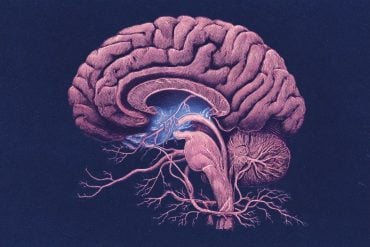Summary: Fear and physiological tension can be reduced by the mere presence of another person, even if the person is unknown and does not offer support.
Source: University of Wurzburg
Going on a journey alone. Sitting in a plane for hours at a height of twelve kilometers above the Atlantic Ocean. With turbulence and all the inconveniences that are part of a long-haul flight. This is the situation Michaela B. is afraid of. If only a friend would be with her on the trip! Then she would certainly feel better.
But Michaela B. shouldn’t be afraid of the situation in the plane. She could easily do without her friend as an escort. Because it would help her to have someone sitting next to her. And this person wouldn’t even have to talk to her or turn to her in any other way. The mere presence would be enough to reduce her fear.
This is the result of a study conducted by a group led by Professor Grit Hein from Julius-Maximilians-Universität (JMU) Würzburg in Bavaria, Germany. The results are published in the Journal Proceedings of the Royal Society B: Biological Science.
Physiological tension measured via skin resistance
“Our results show that fear and the resulting physiological tension can be reduced by the mere presence of another person, even if this person is unknown and does not provide active support,” explains Grit Hein. She holds a professorship for Translational Social Neuroscience at JMU and investigates how social interactions effect decisions, fear and pain.
The reduced anxiety reaction occurred regardless of whether the unknown person belonged to the same or a different ethnic group. “Interestingly, the anxiety-reducing effect was stronger when the subjects perceived the other person as less similar – probably because they then assumed that the other person, unlike themselves, was not afraid,” says the JMU professor.

In the study, the test subjects were listening to either neutral or fear-inducing sounds via headphones – the splashing of water or human cries. Their physical reactions to these sounds were measured via skin resistance – when anxious, the electrical conductivity of the skin changes. The unknown person that was present in the room during the tests was not allowed to say anything and remained physically aloof from the test person. This setting prevented social interaction between the two.
Follow-up studies with men and women
So far, only women have been tested in the presence of women. In follow-up studies, the Würzburg research team now also wants to measure the effects when men with men or men with women are exposed to the uncanny situation in the laboratory.
Differences may become apparent in the process. “There are hints from stress research that the gender of the present person could play a role,” says the JMU professor. The findings from this research could possibly be used for the treatment of anxiety disorders.
Source:
University of Wurzburg
Media Contacts:
Grit Hein, Ph.D. – University of Wurzburg
Image Source:
The image is in the public domain.
Original Research: Open access
“The mere physical presence of another person reduces human autonomic responses to aversive sounds”. Yanyan Qi, Martin J. Herrmann, Luisa Bell, Anna Fackler, Shihui Han, Jürgen Deckert and Grit Hein.
Proceedings of the Royal Society B doi:10.1098/rspb.2019.2241.
Abstract
The mere physical presence of another person reduces human autonomic responses to aversive sounds
Social animals show reduced physiological responses to aversive events if a conspecific is physically present. Although humans are innately social, it is unclear whether the mere physical presence of another person is sufficient to reduce human autonomic responses to aversive events. In our study, participants experienced aversive and neutral sounds alone (alone treatment) or with an unknown person that was physically present without providing active support. The present person was a member of the participants’ ethnical group (ingroup treatment) or a different ethnical group (outgroup treatment), inspired by studies that have found an impact of similarity on social modulation effects. We measured skin conductance responses (SCRs) and collected subjective similarity and affect ratings. The mere presence of an ingroup or outgroup person significantly reduced SCRs to the aversive sounds compared with the alone condition, in particular in participants with high situational anxiety. Moreover, the effect was stronger if participants perceived the ingroup or outgroup person as dissimilar to themselves. Our results indicate that the mere presence of another person was sufficient to diminish autonomic responses to aversive events in humans, and thus verify the translational validity of basic social modulation effects across different species.







